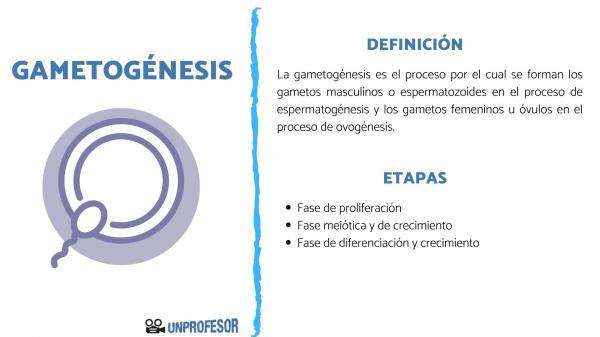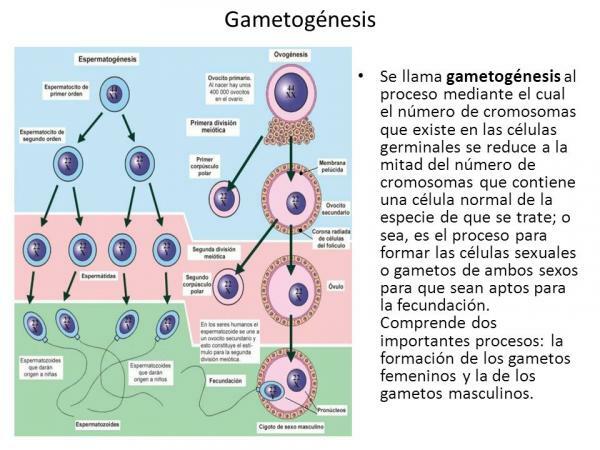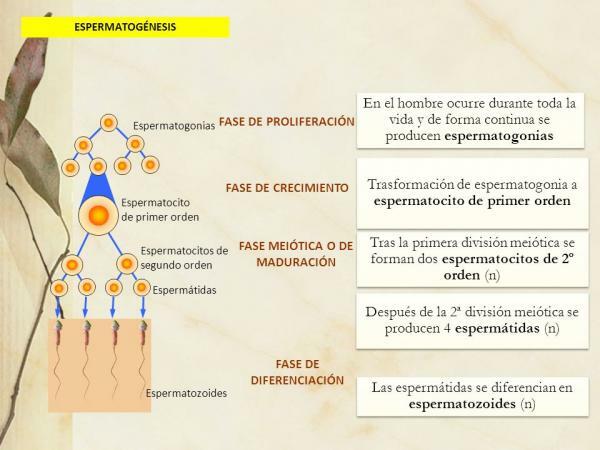What is GAMETOGENESIS and its stages

The gametogenesis is the process by which germ cells of both sexes differentiate and mature into male gametes or sperm and female gametes or eggs suitable for fertilization. It includes meiotic divisions to reduce the number of spermatozoa and a cytodifferentiation to complete the maturation process.
If you want to know more about what is gametogenesis and its stages, continue reading this lesson from a TEACHER.
Index
- What is gametogenesis?
- Stages of gametogenesis: proliferation phase
- Meiotic and growth phase
- Differentiation and growth phase
What is gametogenesis?
As we said, gametogenesis is the process by which the male gametes or sperm in the process of spermatogenesis and the female gametes u ovules in the process of oogenesis.
The primordial germ cells that are housed in the yolk sac In the third week of embryonic development they migrate to structures called gonadal ridges around the fifth week. Once there, these cells mature (and the structures that host them) into mitotically active cells, called spermatogonia in the case of men and oogonia in the case of women, from which they will form the
sperm and eggs.Gametogenesis is a highly hormonally controlled process, controlled by the secretion of gonadotropin-releasing hormone (GNRH), which induces the secretion of luteal hormone (LH) and follicle stimulating hormone (FSH) in the pituitary gland which in turn stimulates the secretion of estrogens, testosterone and other hormones by the gonads. This axis of control is called the hypothalamic-pituitary-gonadal axis.
Oogenesis and spermatogenesis are not completely the same, they also differ in their development times, being oogenesis much more complex, although the process is finally equivalent.

Image: Slideplayer
Stages of gametogenesis: proliferation phase.
We start with the first of the stages known as the proliferation phase.
Spermatogenesis
In men, germ cells and the structures that house them mature until puberty, when the seminiferous tubules that house the spermatogonia (cells mitotically active). Of these cells, the dark type A spermatogonia are reserve cells and will be the pale type A spermatogonia. those that will divide into type B spermatogonia, which will undergo mitosis to form primary spermatocytes during puberty. These will consist of the diploid number of chromosomes of the human species (46).
Oogenesis
Once the primordial germ cells have reached the female gonad they differentiate into oogonia, which undergo a series of mitotic divisions, reaching 7 in the fifth month of fetal development millions. This figure represents the maximum number of germ cells that the ovary contains.
Meiotic and growth phase.
From here on, spermatogenesis and oogenesis differ much more.
Spermatogenesis
Primary spermatocytes (2n) enter meiosis I and undergo a prophase prolonged (22-24 days) to end with the formation of 2 secondary spermatocytes (n). During this longer meiosis, compounds are synthesized that are necessary for the later phases. Secondary spermatocytes enter meiosis II and complete it in 8 hours, each giving rise to 2 spermatids (n). All these cells possess the haploid number of chromosomes of the human species (n = 23).
Oogenesis
A high number of oogonia (2n) suffer atresia and degeneration, but a small percentage begins meiosis I around week 12 of fetal development. During this phase the cell is known as the primary oocyte (2n), located towards the superficial part of the ovary, and are surrounded by flat follicular cells, here they are called primordial follicles. When primary oocytes enter the diplotene phase of meiosis I, they stop and do not continue dividing (dictyotene state). This pause can last 45 years or more, and allows the oocyte to prepare itself to meet the future needs of the embryo.
Differentiation and growth phase.
The last of the stages of gametogenesis is known as the differentiation and growth phase.
Spermiogenesis
The last stage of spermatogenesis is called spermiogenesis and it is a differentiation phase in which the spermatids (n) undergo several things: reduction and condensation of the nucleus, loss of part of the cytoplasm and completion of its division, elongation of the head and tail, accumulation of mitochondria in the initial part of the tail and formation of the acrosome around the vertex of the head. After this process, male gametes or sperm are formed, although they still have to undergo two more processes to be able to carry out fertilization.
Oogenesis
Many of these primary oocytes degenerate and by puberty about 40,000 remain available. Of these, about 400-500 will ovulate each month until they reach menopause.
After birth, the primordial follicles grow and are surrounded by another layer called the zona pellucida, forming the primary follicle. Later this is surrounded by two other layers, which produce estrogens, forming the secondary follicle. It continues to grow until it forms the tertiary or preovulatory follicle. After this, an LH surge occurs and the primary oocyte leaves the follicle, a process called ovulation, and completes meiosis I. The secondary oocyte (n) formed subsequently enters meiosis II, which is only completed if there is fertilization, to form the definitive oocyte or fertilized ovum (n).

Image: Slideplayer
If you want to read more articles similar to What is gametogenesis and its stages, we recommend that you enter our category of biology.
Bibliography
Ross, M. H., & Pawlina, W. (2013). Histology: Text and color atlas with cellular and molecular biology (6th. ed.). Buenos Aires: Panamerican Medical.



